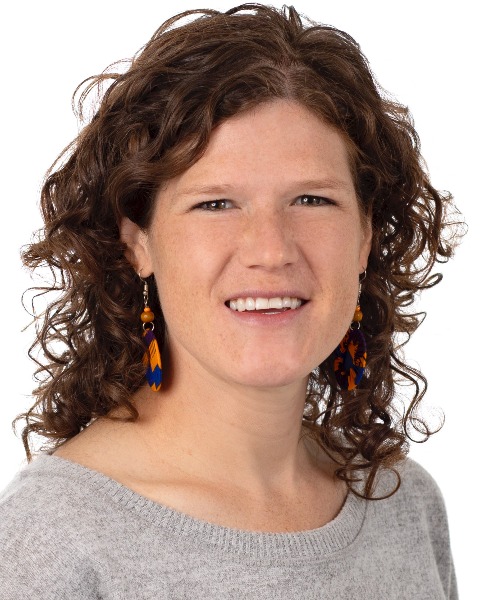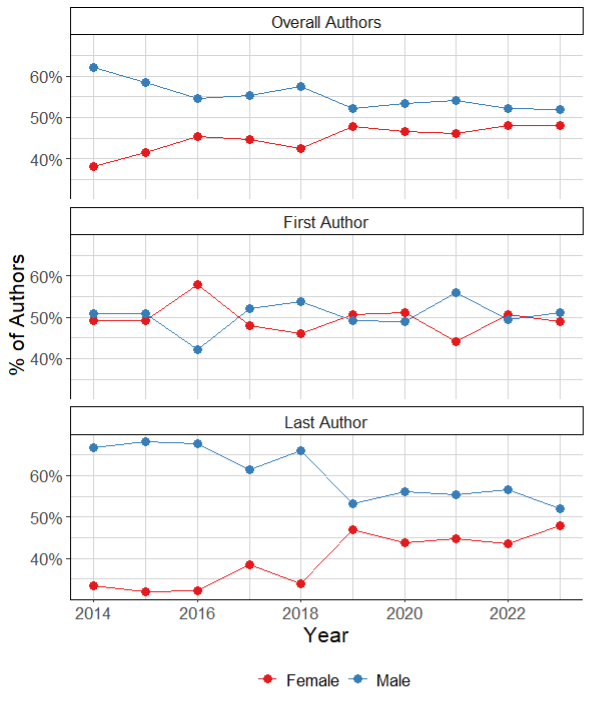Global Neonatal & Children's Health 4
Session: Global Neonatal & Children's Health 4
769 - Authorship gender composition in leading global child health journals
Sunday, April 27, 2025
8:30am - 10:45am HST
Publication Number: 769.3647
Elizabeth M. Keating, University of Utah, Salt Lake City, UT, United States; Kajsa Vlasic, University of Utah School of Medicine, Salt Lake City, UT, United States; Maddy Vonderohe, Primary Children's Hospital, Salt Lake City, UT, United States; Gouri Rajesh, Wright State University Boonshoft School of Medicine, Dayton, OH, United States; Bryan Young, University of Utah, Salt Lake City, UT, United States; Chris A. Rees, Emory University School of Medicine, Atlanta, GA, United States; Isabella G. Rehberg, Emory University School of Medicine, Atlanta, GA, United States; Nora Fino, University of Utah School of Medicine, Salt Lake City, UT, United States; Blandina Theophil. Mmbaga, Kilimanjaro Clinical Research Institute, Moshi, Kilimanjaro, Tanzania; Aisa M. Shayo, Kilimanjaro Christian Medical Center and Kilimanjaro Christian Medical University College, Moshi, Kilimanjaro, Kilimanjaro, Tanzania; Frida Shayo, Kilimanjaro Christian Medical University College, Moshi, Kilimanjaro, Tanzania; Catherine R. Shari, Muhimbili National Hospital- Mloganzila, MUHAS, DAR ES SALAAM, Dar es Salaam, Tanzania

Elizabeth M. Keating, MD, MSPH (she/her/hers)
Assistant Professor
University of Utah School of Medicine
Salt Lake City, Utah, United States
Presenting Author(s)
Background: There is a lack of gender parity in leadership positions in global health. Although females make up 70% of the health workforce worldwide, they hold just a quarter of the global health leadership positions. We hypothesized that such disparities exist in authorship in global child health publications. Identifying disparities in author gender in global child health publications has the potential to inform more equitable authorship practices.
Objective: To determine author name gender composition in global child health publications conducted in low- and middle-income countries (LMICs) and determine if more prestigious authorship positions are more often occupied by males.
Design/Methods: We conducted a cross-sectional analysis of publications in five leading global child health journals (Paediatrics and International Child Health, Global Pediatric Health, Journal of Tropical Pediatrics, Global Pediatrics, and Lancet Child and Adolescent Health) from January 2014 to December 2023. We included publications that reported on global child health topics or took place in LMICs. We excluded publications that reported research conducted in high income countries, or that we could not access. We extracted study type, author first name, author affiliation, and study country from each included publication. Our primary outcome was the proportion of authors whose names were male or female as assigned using author first name and the software genderize.io. Descriptive and Chi-square statistics were performed in SAS.
Results: Of 3769 publications reviewed, 1897 (50.3%) were included. Of these, 75.6% (n=1433) reported original research. There was a total of 10494 authors, and less than half (45.7%) had female names. The disparity between male and female authors decreased from 2014 to 2023 (Figure). Female first authors were not less common than male first authors (48.9% female, p=0.35). However, female senior authors were less common than male senior authors (41.3% female, p< 0.001). Over 70% of both first and last authors were affiliated with institutions in LMICs (72.4% and 73.2%, respectively). Publications with authors affiliated with institutions in LMICs were less likely to have female first authors (OR 0.82, 95% CI 0.68, 0.99).
Conclusion(s): There were more male authors in leading global child health publications, though the gender gap decreased over time. Female authors were less likely to hold senior authorship positions in publications on global child health. This disparity should inspire further efforts by investigators, funders, and journal editorial boards in global child health to encourage authorship by females.
Figure 1. Trends in author gender in publications from leading global child health journals from 2014 to 2023.

Figure 1. Trends in author gender in publications from leading global child health journals from 2014 to 2023.


